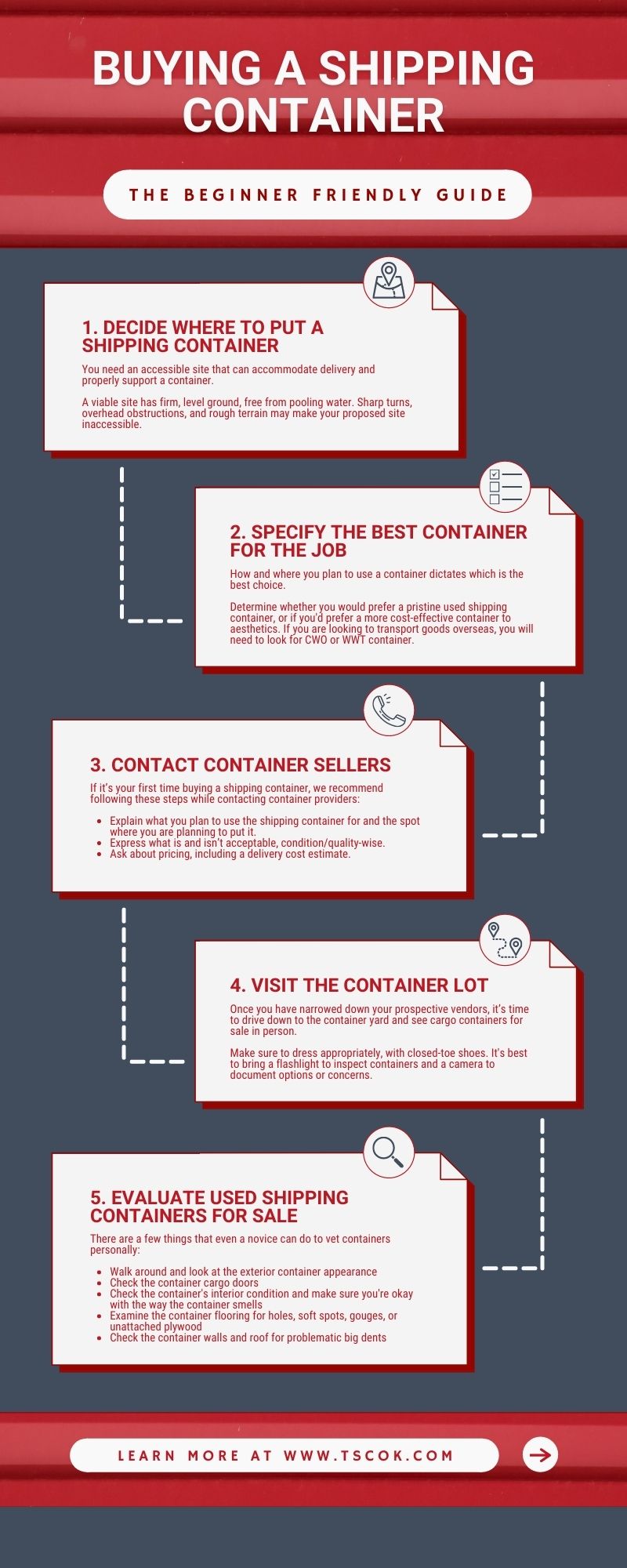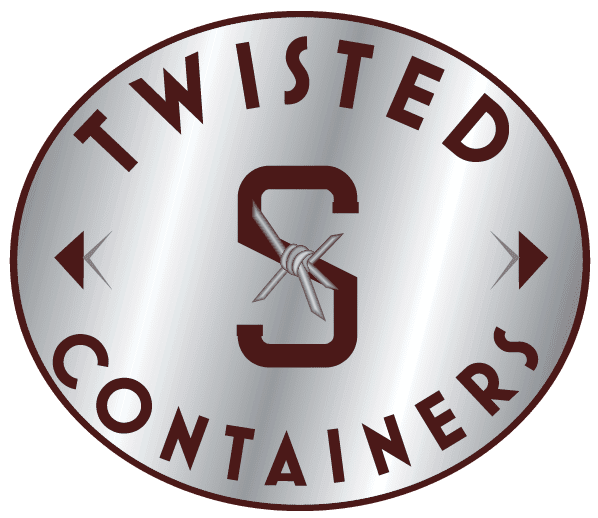Knowing how to choose and how to buy a shipping container is important. It can mean the difference between a good portable storage solution and a bad investment. Buying a shipping container is a pretty simple process. But, if you haven’t done it before, you may not know the ins and outs.
In this article, we will discuss the process of how to buy shipping containers. This includes the general process of buying a container and providing tips and reminders to ensure it’s as smooth as possible.
Shipping Container Basics Guide
Whether your plans include building an eventual shipping container home, buying multiple containers, or finding just one water tight container for a simple backyard storage shed, each shipping container purchase starts with the basics. You need to start by answering the question: which size of shipping container do I need?
Choosing the right container type starts with knowing a little bit about shipping container sizes and dimensions. ISO standard containers are 8 feet wide, 8 feet 6 inches tall or 9 feet 6 inches tall (called high cube (HC) containers). They range in length from 8 to 53 feet long. But, the majority of containers are two sizes: 20 foot or 40 foot containers. The further you are from a major shipping port, the more likely your cargo worthy options will be limited to these two common container sizes. Though these are similar to a high cube container, there is a height difference.
| Square Feet | |
| 20 Foot Container | 150 |
| 40 Foot Container | 305 |
Read More: Shipping Container Specifications
Each container size can be found in various conditions in the wild. To simplify, within the container industry, particular terms classify some of the most common conditions:
- 1-trip containers are the newest and best-looking (and most expensive). If you want a nearly new shipping container for cosmetic reasons, this is your ideal, high-quality container in the best condition.
- Cargo-worthy (CWO) containers meet current safety standards and have been inspected and certified for overseas shipping.
- Wind and watertight (WWT) containers make up the majority of used containers in the resale market. They are generally older than CWO containers and may look worse on the outside, including surface rust. WWT containers should be in good condition for your self storage needs.
- As-Is containers are the riskiest in terms of container condition. They will likely have more wrong with them than a little surface rust. However, for some projects, like a shipping container house, you may already plan to make your own holes.

Share this Image On Your Site
How to Buy a Shipping Container in 5 Steps
1. Deciding Where to Put a Shipping Container
Before you make any final decisions on a used storage container, you need an accessible site that can accommodate delivery vehicles and properly support a container.
A viable site has a firm, level ground, free from pooling water. On less-firm surfaces (that aren’t asphalt), it’s best to put down a leveled foundation, 4 concrete blocks, or lay railroad ties under both ends of the container to keep it level. If a container isn’t level, opening the doors becomes impossible.
Both 40 and 20 foot containers are delivered on a large, heavy truck. Sharp turns, overhead obstructions, and rough terrain may make your proposed site inaccessible.
If you are uncertain about where to put your new container, or you have questions about a site’s viability, make a note to ask each container sales company questions about their delivery methods, space needs, and any other container delivery logistics before buying a shipping container.
Read more: How to Prep Ground for Shipping Container Placement
2. Specifying the Best Container for the Job
A steel storage container is a cost-effective, long-term solution for many applications. People buy steel shipping containers for shipping overseas, for building and DIY projects, and for storage. Agricultural, residential, construction, and on-site business storage are common. Each situation calls for different container capabilities. How and where you plan to use a used or modified shipping container dictates which best choice.
If you are looking to buy used shipping containers to pack up cargo and transport goods overseas, you will need to look for a cargo worthy shipping container (CWO) with a valid CSC safety survey or a WWT container which you can pay to have re-certified for shipping.
If you want a pristine used shipping container for a building project or a public storage site where looks matter, your best bet is a one-trip container. Short of commissioning a brand new container (which can greatly raise your shipping container cost), a one-tripper is the closest thing. It was built within the last year and was used for just one overseas cargo shipment. It may have some scuff marks and dings, but the paint job will look the most uniform, and it will be in the best condition.
In cases where aesthetics don’t matter as much, priorities shift to finding a cost-effective specialty container that is structurally sound. In this case, a wind and watertight (WWT) steel shipping container is what you are looking for. WWT containers are several years old and used repeatedly for shipping cargo. While they are wind and water tight, with an intact door seal, appearances vary greatly. You will likely pay more for a better-looking container. Rust, dents, welded patches, and dings are commonplace, but there should be no holes.
If exterior looks matter for your shipping container purchase, then it’s important you make it clear to your vendor. This could potentially cut your shipping cost.
Read more: Beginner’s Guide to Shipping Container Conditions
3. Contacting Container Sellers
If you don’t know where to buy shipping containers, they are available from three main sources:
- Global shipping container companies — For the most part, these are companies that manufacture containers overseas, lease them to shipping companies for use on cargo ships, and then sell them. Big multinational container services may have a larger distribution network, but it may not reach less populous areas. They won’t have a local presence, so shipping a container to you can get expensive.
- Local shipping container companies — Third parties that buy used shipping containers and transport them to their local community for sale. Local container companies work with lower volumes but can offer customers more opportunities for custom requests and personalized modifications.
- Individuals posting used shipping containers for sale online — These are the most variable type of sellers, and going through an individual will require the most work. You may have to coordinate shipping on your own.
There are places across the country where you can purchase a shipping container, either new or used. Find shipping container sellers online or through local contacts. Then contact the companies by phone, social media, or email. Be aware that shipping container pricing will vary between vendors.
If it’s your first time buying a shipping container, we recommend following these steps while contacting container providers.
- Explain what you plan to use the shipping container for and the spot where you plan to put it.
- Express what is and isn’t acceptable, condition/quality-wise.
- Ask about shipping container pricing, including a delivery cost estimate.
Read more: 5 Things That Can Mess Up Delivery Day
4. Visiting the Container Lot
Once you have narrowed down your prospective vendors, it’s time to drive down to the container yard and see cargo containers for sale in person. Make sure to dress appropriately, with closed-toe shoes. It’s best to bring a flashlight to inspect every cargo worthy container yourself and a camera to document options or concerns. Of course, you can just bring your (well-charged) smartphone to kill two birds.
5. Evaluating Used Shipping Containers for Sale
Vetting and selecting a quality standard container may seem beyond your grasp; however, there are a few things that even a novice can do to vet every standard container (and be able to tell the difference). Once you get to know the basics of shipping container architecture, you’ll be a pro at choosing the best ones for your projects.
Exterior Container Appearance
First, walk around the container and look at its overall shape. Check that you are looking at a rectangle, not a parallelogram. Angles should be as close to 90 degrees as possible. If already listing to one side, steer clear.
Depending on your intended use, the steel container’s aesthetic appearance may or may not matter to you. It’s okay to let the sales team know. It’s also okay to pass on containers that won’t suit your needs.
Container Cargo Doors
Next, it’s time to check the doors. Most shipping containers have doors on one end of the container that uses special lock box assist mechanisms and handles. Containers spend most of their working life with the doors closed. Consequently, the cargo door may tend to be sticky. Lock rods should be straight and undamaged. You want to be sure that you can open the doors before buying a used shipping container.
Here is a helpful video: How to Open and Close a Shipping Container Door
Once the doors are open, check that the rubber door seals are in good shape and that doors close all the way. This is especially important because you want your cargo or stored equipment to stay dry.
Container Interior Condition
Once the doors are opened, take a whiff. Used cargo containers will have a smell, but smells vary depending on what containers have been used for, such as storage space versus cargo shipments. Make sure that you are ok with the way the container smells before buying a container. If not, consider buying new containers instead.
Next, with a flashlight, walk all the way into the container and have someone angle the door nearly closed. Turn your flashlight off and look for holes once your eyes have adjusted. Any holes are a bad sign. If light can get through, water can, too.
Container Flooring
When buying storage containers, take a walk around with your flashlight to examine the floor. Container floors are made of 1 ⅛ inch thick marine plywood attached to the steel frame of the cargo container. It can have some scuff marks from use but shouldn’t have holes, soft spots, gouges, or unattached plywood.
Container Walls & Roof
Dents and rust are normal. However, big dents that change the shape of a container are bad. For example, if a forklift runs into the shipping container wall and the metal crunches, the angle of the wall to the door, floor, or roof will be affected.
6 Tips and Reminders for Buying Standard Shipping Containers
1. Look for Guarantees — Buying shipping containers from a container dealer that guarantees the quality or condition of its containers helps avoid scams.
2. Read Company Reviews — You check customer reviews before buying a pizza. Why not check customer reviews before buying a container?
3. Get the Full Price with Delivery Fee — Don’t forget to factor any delivery fees into your pricing decision when you buy a container.
4. Be Available for Delivery — If you cannot be there in person, know the return policy/condition guarantee.
5. Ask About Container Modification — If you plan to modify your container, adding windows or insulation, factor this into used shipping container prices. Additionally, it never hurts to ask if the container company can do mods for you. That way, when your container is delivered, you can hit the ground running.
6. Prepare the Site — It’s vital to clear the delivery truck’s path and prepare a flat, level, dry area for your container. For some projects, a shipping container foundation is necessary; for others, temporary measures will do. Factor your foundation needs into your initial shipping container budget.
Buying a Shipping Container in OKC
Still, have questions about how to buy a used shipping container? Twisted S Containers can help you through the process. We sell handpicked 20 and 40-foot containers in Oklahoma and surrounding states. Quality shipping containers, guaranteed. Free delivery is available within 60 miles of our Nicoma Park container yard. Contact Twisted S Containers today!
Read More: Do I Need a Permit for My Shipping Container? What are Shipping Containers Made of?

